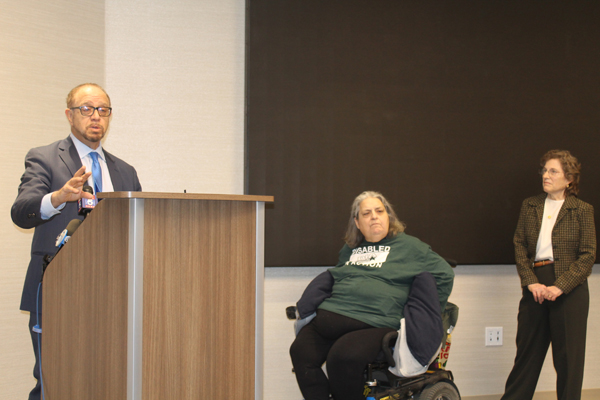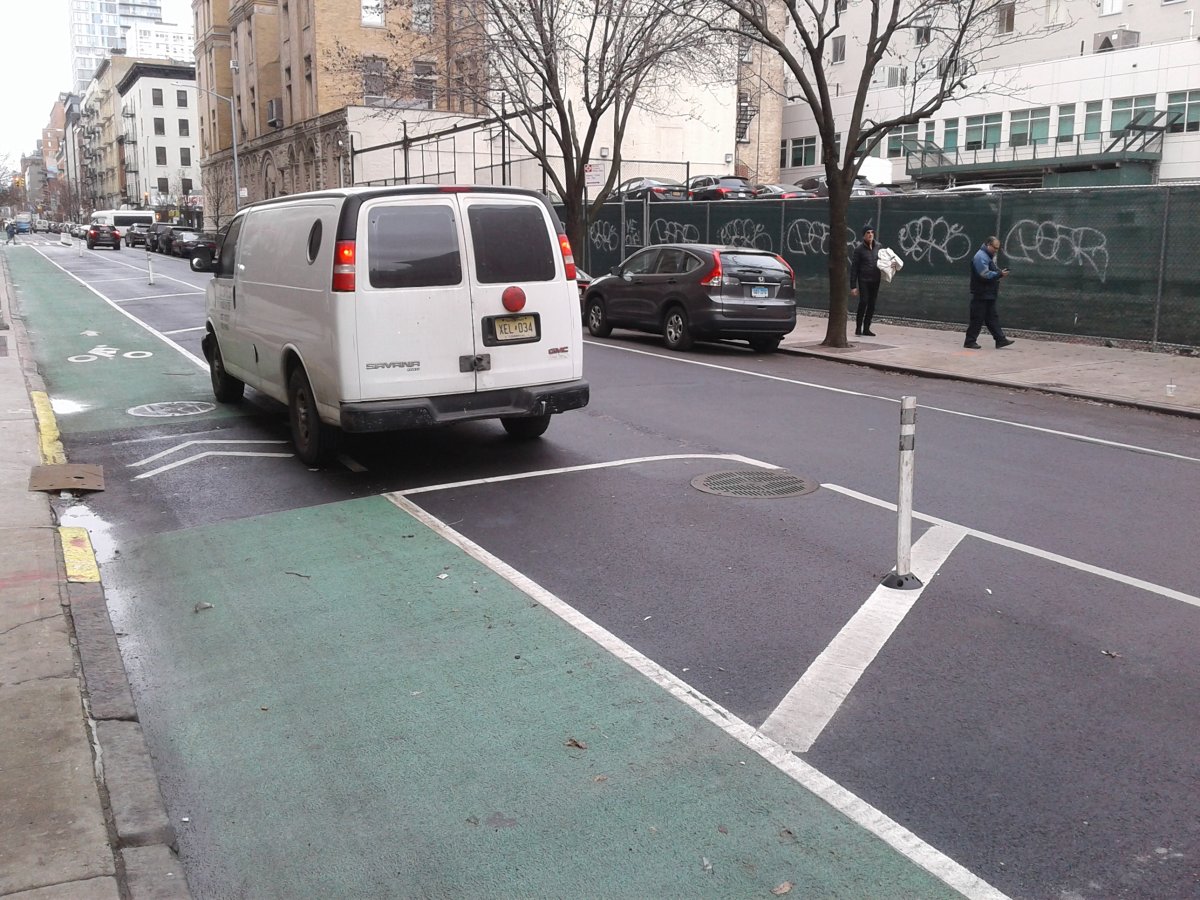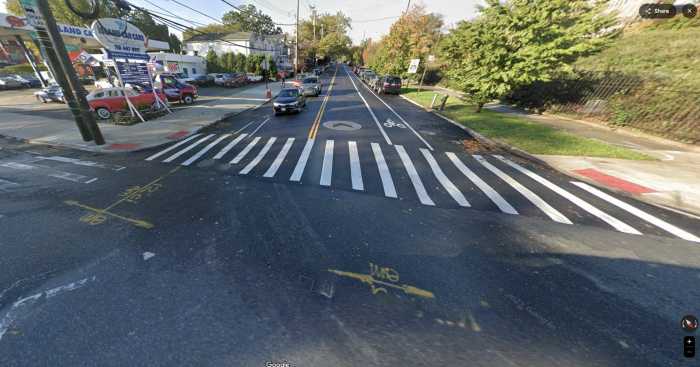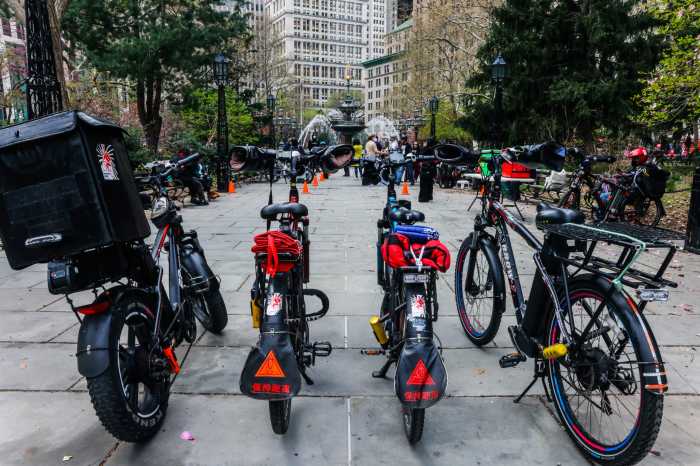BY LINCOLN ANDERSON Updated Tues., June 25, 5:20 p.m. | Not so fast!
The city is determined to make 14th St. a transportation “experiment” by banning cars to speed up bus service. The changes are set to start July 1 in what’s being dubbed an 18-month “pilot project.”
But slamming the transit scheme as “arbitrary and capricious,” a Village activist attorney last Thursday lodged a lawsuit in State Supreme Court to stop the plan in its tracks.
Democratic District Leader Arthur Schwartz filed suit on behalf of 16 plaintiffs, ranging from Chelsea and Village block associations and large co-op apartment buildings to several individuals, including himself.

It’s an Article 78 lawsuit, meaning it challenges a city decision. And it’s filed against one individual: Polly Trottenberg, commissioner of New York City’s Department of Transportation.
In addition, Schwartz said he would file suit this week against the New York City Transit Authority’s plan to cut bus stops on the M14 route to transform it into Select Bus Service. That suit — with plaintiff Disabled in Action — will argue that slashing the number of stops would harm people with disabilities.
The first lawsuit asks for a temporary restraining order, or T.R.O., to be enforced against the 14th St. so-called Transit/Truck Priority lanes plan — a.k.a. the “busway” — as well as against the new crosstown bike lanes on 12th and 13th Sts. The plaintiffs argue that both the 14th St. plan and the bike lanes must be reviewed under the State Environmental Quality Review Act (SEQRA) and the City Environmental Quality Review (CEQR) — and that the bike lanes and their respective protective buffer areas must be narrowed to allow for a 16-foot-wide roadway for moving traffic, increasing from the 10-foot roadway that has been left due to the lanes’ installation.
In short, the lawsuit contends that the plan to “restructure” 14th St. should not be done until both it and the bike lanes are “properly evaluated,” with an environmental assessment and, if necessary, a more rigorous environmental impact statement, or E.I.S.
More to the point, the suit charges, the scheme cannot be allowed to proceed unless “some modicum of rationality” is shown to justify it.
Under the city’s plan, 14th St. from Third to Ninth Aves. would be reduced to one lane of moving traffic in each direction, and cars would be banned on the street daily from 6 a.m. to 10 p.m. Buses, through trucks and emergency vehicles would be allowed to travel along the major Downtown crosstown artery. Cabs and for-hire vehicles would be permitted to come onto 14th St. for drop-offs but would then have to take their first right turn off of 14th St. Similarly, for-hire cars would be allowed to come onto 14th St. for pick-ups — though yellow taxis would be banned from doing so. People would also be allowed to drive onto the street to access parking garages.
The current busway scheme is a version of the one the city was pitching when the L train was going to be shut down for 15 months for repairs. At that time, the Metropolitan Transportation Authority estimated that, with the L shutdown, an additional 30,000 commuters per day would take the M14 bus crosstown, while D.O.T. said an additional 2,000 to 5,000 cyclists would be biking crosstown.
But this January, Governor Andrew Cuomo declared the L train repairs could be done on nights and weekends, avoiding a full shutdown, and that partial L service would always be maintained, even during the construction work. It seemed the busway was done for.
Yet, in April, the plan was revived, with trucks now allowed to use 14th St., too. (During the earlier iteration of the plan, residents had raised the alarm about trucks being pushed onto their side streets.) And it was also announced that the bike lanes — previously pitched as merely temporary during the expected “L-pocalypse” — would now, in fact, be permanent.
Meanwhile, the same complaints that led Chelsea, Village and Flatiron residents to sue over the busway a year ago remain. Among the biggest concerns, the suit says, is that neighboring side streets from 12th St. to 20th St. would be flooded with car and truck traffic displaced from 14th St., “bringing with it air pollution, noise and vibrations endangering the 19th-century buildings which line these blocks, challenging the character of Greenwich Village, Chelsea and Flatiron communities, and likely causing delay in the crosstown transit of emergency vehicles.”
Historic districts line 14th St. and the surrounding side streets, the suit notes.
The plaintiffs include Council of Chelsea Block Associations; Flatiron Alliance; W. 12th St. Block Association; Upper W. 13th St. Block Association; W. 13th St. 100 Block Association; 100/200 W. 15th St. Block Association; 100 W. 17th and 18th Sts. Block Association; 16th St. Tenants Corp. (a co-op at 16 W. 16th St.); 13 W. 13th Apartment Corporation (a co-op); Cambridge Owners Corporation (a co-op at 175 W. 13th St.); Victoria Owners Corporation (a co-op at 7 E. 14th St.); Vermeer Owners Corp. (a co-op at 777 Seventh Ave., at 14th St.); John Wetherhold; David Marcus and Julianne Bond; and Schwartz individually in his capacity as male district leader for the 66th Assembly District, Part A (Greenwich Village). Schwartz is also a W. 12th St. resident.
While the plan itself has not changed much from before, the justification for it has.
As the lawsuit notes, “D.O.T. has switched its motivation for reworking 14th St. from accommodation of riders inconvenienced by the L train to a need to make cross-14th St. buses ‘run faster.’ No new rationale has been stated for the two bike lanes constructed before the [L-train] shutdown was called off, which were supposed to be ‘temporary’ and were designed to serve L-train riders who chose to bicycle across Greenwich Village. This shifting rationale, despite meetings with various community boards, several of which have denounced some or all aspects of the plans, is not how government in New York City, or anywhere in New York State, is supposed to function.”
Community Board 4 (Chelsea/Hell’s Kitchen), earlier this month, voted 45 to 0 to oppose the 14th St. changes due to lack of “inclusion of a comprehensive mitigation plan for the adjacent residential streets.”
In March, Community Board 3 (East Village/Lower East Side), weighing in on the Select Bus Service issue, said it would not support removing M14 stops, “which will be a terrible burden to underserved residents of C.B. 3 and institutions of the Lower East Side.”
Although the new rationale for the 14th St. plan is to speed up the buses, the suit notes that it is, in fact, one of two crosstown streets in Manhattan that “has a subway running across almost its entire length” (the other being 42nd St.).
“The plans…are the government thumbing its nose at the views of residents and the character of three neighborhoods in order to speed up buses by one or two miles per hour and promote use of bicycles,” the suit scoffs, urging, “This Court’s intervention [to stop the plan] is sorely needed.”

Submitted along with the lawsuit was a survey of bike use in the new 12th and 13th St. bike lanes. Basically, attorney Schwartz and five law students counted cyclists using the bike lanes between Broadway and Sixth Ave. on May 30 from 8 a.m. to 10 a.m.
On 12th St., which runs eastbound, on the block between University Place and Fifth Ave., they counted 75 bikes over the two-hour period, or roughly one bike every one-and-a-half minutes. On 13th St., which runs westbound, between University Place and Fifth Ave., they counted 281 bikes, or roughly 2.3 bikes per minute.
Schwartz also included as exhibits 50 photos he took showing vehicles blocking the bike lanes — plus one of a ladder blocking the bike path — as well as a “Mobile Heating Unit” truck parked on 12th St. near University Place and Broadway that was only recently finally moved out of the lane and into the buffer zone.
“If an oil truck is making deliveries, nothing will be able to pass,” the suit asserts, adding that garbage trucks and fire trucks are 9 feet wide. In all, 550 parking spaces were eliminated to create the new bike lanes, according to the suit.
More serious, however, the litigation charges, “Traffic delays on streets heading eastbound could be life-threatening.”
Because there is no hospital on the “west side of the 14th St. Corridor,” the Lenox Health Greenwich Village stand-alone emergency department, at 12th St. and Seventh Ave., often transports patients by ambulance to hospitals for higher-level care, such as to Mt. Sinai-Beth Israel, on the East Side. But the proposed 14th St. traffic plan and the 12th St. bike lane, the suit maintains, would cause “horrific traffic jams,” putting patients at risk.
In particular, 12th and 13th Sts. would be hammered by displaced traffic, the suit argues, since, due to Union Square Park and Stuyvesant Town, those streets are the only through routes river to river south of 20th St.
Schwartz is also demanding that D.O.T. respond to his as-yet-unanswered requests under the Freedom of Information Law for bike counts, vehicle counts and pollution and vibration studies in connection with the 14th St. plan and 12th and 13th Sts. bike lanes.
Meanwhile, the attorney accuses D.O.T. of “hiding” data and throwing around “made-up numbers” about how many straphangers have 14th St. as their destination.
The plaintiffs further fear that the alleged pilot project would be become permanent.
“The city calls this ‘an 18-month pilot project,’ but given its determination since 2017 to impose these changes, there is no reason not to believe that a permanent change is what is in store,” the suits alleges. “Residents of the affected communities should not be treated as subjects in an experiment. … There is no demonstrable need to proceed now, other than because an arbitrary date was chosen by D.O.T. On the other side, the fabric of a community will be ripped apart.”
However, a city Law Department spokesperson said the lawsuit has “no merit,” the New York Post reported.
D.O.T. “followed all applicable procedures and should be allowed to complete this initiative,” Nicholas Paolucci told the tabloid.
Schwartz said he’ll be in court this Fri., June 28, at 71 Thomas St., at 10 a.m., and — based on his initial interaction with the judge, Eileen Rakower, on Monday — feels pretty good about the chance of snagging a T.R.O. He’s urging a big community turnout at court.
Meanwhile, the Riders Alliance, one of the city’s leading transportation advocacy groups, which is fully onboard with the busway plan, derided the legal challenge as “Not In My Backyard’ism.”




































